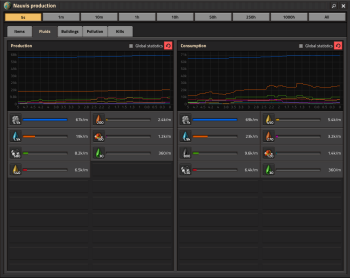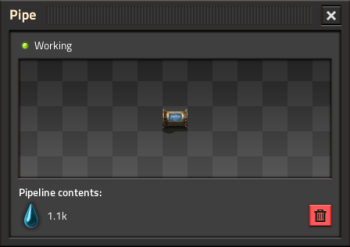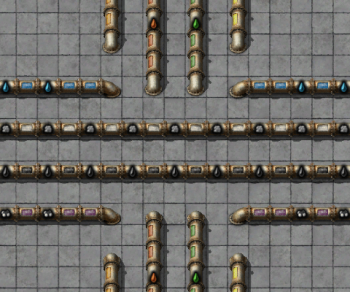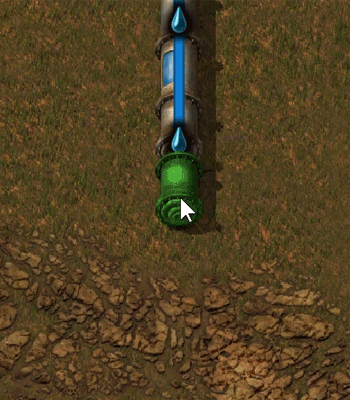Fluid system: Difference between revisions
Tincopper2 (talk | contribs) mNo edit summary |
Removed some duplicate content. |
||
| (104 intermediate revisions by 30 users not shown) | |||
| Line 1: | Line 1: | ||
{{Languages}} | {{Languages}} | ||
[[File:Item-group fluids.png|right]] | |||
'''Fluids''' are non-solid items, such as [[water]] and [[oil]]. They can normally only exist inside entities for fluid handling (like [[pipe]]s), and buildings that have fluids as input ingredients or products (like an [[oil refinery]]). | |||
== Fluids == | |||
The following fluids are available in-game: | |||
[[File:fluids_gui.png|thumb|350px|right|"Fluids" tab on the [[production statistics]] screen.]] | |||
{| class="wikitable" | {| class="wikitable" | ||
|- | |- | ||
| {{ | ! Fluid !! Resource distribution !! Extractor !! Alternative recipes !! Producer | ||
|- | |||
| {{iconLink|Water}} || {{icon|Nauvis}}{{icon|Gleba|space-age=yes}} || {{icon|Offshore pump}} || {{icon|Ice melting|space-age=yes}}{{icon|Steam condensation|space-age=yes}} || {{icon|Chemical plant}}{{icon|Cryogenic plant|space-age=yes}} | |||
|- | |||
| {{iconLink|Steam}} || N/A || N/A || {{icon|Acid neutralisation|space-age=yes}} || {{icon|Boiler}}{{icon|Heat exchanger}}{{icon|Chemical plant}}{{icon|Cryogenic plant|space-age=yes}} | |||
|- | |||
| {{iconLink|Crude oil}} || {{icon|Nauvis}}{{icon|Aquilo|space-age=yes}} || {{icon|Pumpjack}} || N/A || N/A | |||
|- | |||
| {{iconLink|Petroleum gas}} || N/A || N/A || {{icon|Basic oil processing}}{{icon|Advanced oil processing}}{{icon|Light oil cracking}}{{icon|Coal liquefaction}} || {{icon|Oil refinery}}{{icon|Chemical plant}}{{icon|Biochamber|space-age=yes}} | |||
|- | |||
| {{iconLink|Light oil}} || N/A || N/A || {{icon|Advanced oil processing}}{{icon|Heavy oil cracking}}{{icon|Coal liquefaction}} || {{Icon|Oil refinery}}{{Icon|Chemical plant}}{{Icon|Biochamber|space-age=yes}} | |||
|- | |||
| {{iconLink|Heavy oil}} || {{icon|Fulgora|space-age=yes}} || {{icon|Offshore pump}} || {{icon|Advanced oil processing}}{{icon|Coal liquefaction}}{{icon|Simple coal liquefaction|space-age=yes}} || {{icon|Oil refinery}} | |||
|- | |||
| {{iconLink|Lubricant}} || N/A || N/A || {{icon|Lubricant}}{{Icon|Biolubricant|space-age=yes}} || {{Icon|Chemical plant}}{{Icon|Biochamber|space-age=yes}} | |||
|- | |||
| {{iconLink|Sulfuric acid}} || {{icon|Vulcanus|space-age=yes}} || {{icon|Pumpjack}} || {{icon|Sulfuric acid}} || {{icon|Chemical plant}} | |||
|- | |||
| {{iconLink|Thruster fuel|space-age=yes}} || N/A || N/A || {{icon|Thruster fuel|space-age=yes}}{{icon|Advanced thruster fuel|space-age=yes}} || {{Icon|Chemical plant}} | |||
|- | |||
| {{iconLink|Thruster oxidizer|space-age=yes}} || N/A || N/A || {{icon|Thruster oxidizer|space-age=yes}}{{icon|Advanced thruster oxidizer|space-age=yes}} || {{Icon|Chemical plant}} | |||
|- | |||
| {{iconLink|Lava|space-age=yes}} || {{icon|Vulcanus|space-age=yes}} || {{icon|Offshore pump}} || N/A || N/A | |||
|- | |||
| {{iconLink|Molten iron|space-age=yes}} || N/A || N/A || {{icon|Molten iron|space-age=yes}}{{icon|Molten iron from lava|space-age=yes}} || {{icon|Foundry|space-age=yes}} | |||
|- | |- | ||
| {{ | | {{iconLink|Molten copper|space-age=yes}} || N/A || N/A || {{icon|Molten copper|space-age=yes}}{{icon|Molten copper from lava|space-age=yes}} || {{icon|Foundry|space-age=yes}} | ||
|- | |- | ||
| {{ | | {{iconLink|Holmium solution|space-age=yes}} || N/A || N/A || {{icon|Holmium solution|space-age=yes}} || {{Icon|Chemical plant}} | ||
|- | |- | ||
| {{ | | {{iconLink|Electrolyte|space-age=yes}} || N/A || N/A || {{icon|Electrolyte|space-age=yes}} || {{Icon|Electromagnetic plant|space-age=yes}} | ||
|- | |- | ||
| {{ | | {{iconLink|Ammoniacal solution|space-age=yes}} || {{icon|Aquilo|space-age=yes}} || {{icon|Offshore pump}} || N/A || N/A | ||
|- | |- | ||
| {{ | | {{iconLink|Ammonia|space-age=yes}} || N/A || N/A || {{icon|Ammoniacal solution separation|space-age=yes}} || {{icon|Chemical plant}}{{icon|Cryogenic plant|space-age=yes}} | ||
|- | |- | ||
| | | {{iconLink|Lithium brine|space-age=yes}} || {{icon|Aquilo|space-age=yes}} || {{icon|Pumpjack}} || N/A || N/A | ||
{| | |||
| {{ | |||
|- | |- | ||
| {{ | | {{iconLink|Fluorine|space-age=yes}} || {{icon|Aquilo|space-age=yes}} || {{icon|Pumpjack}} || N/A || N/A | ||
|- | |- | ||
| {{ | | {{iconLink|Fluoroketone (hot)|space-age=yes}} || N/A || N/A || {{icon|Fluoroketone (hot)|space-age=yes}} || {{icon|Cryogenic plant|space-age=yes}} | ||
|- | |- | ||
| {{ | | {{iconLink|Fluoroketone (cold)|space-age=yes}} || N/A || N/A || {{icon|Cooling hot fluoroketone||Fluoroketone (cold)|space-age=yes}} || {{icon|Cryogenic plant|space-age=yes}} | ||
|- | |- | ||
| {{ | | {{iconLink|Plasma|space-age=yes}} || N/A || N/A || {{icon|Plasma|space-age=yes}} || {{icon|Fusion reactor|space-age=yes}} | ||
|- | |- | ||
|} | |} | ||
== | == Mechanics == | ||
< | Fluids cannot be carried by the player, moved using [[inserters]], dropped on the ground, nor stored in chests, unless the fluids are stored in [[barrel]]s. They cannot be spilled or even dumped in a lake, and are counted in continuous fractions, rather than discrete integers.<br> | ||
When the player picks up a structure that contains fluids, the contained fluid will try to flow into connected structures and any excess fluid that does not fit is destroyed. | |||
[[File:Pipe_GUI.png|right|thumb|350px|GUI of a pipe inside a fluid system containing water. Clicking the trash can icon next to a fluid will flush that fluid from the system.]] | |||
=== Storage === | |||
In the game, fluid is held in entities that behave as vessels (fluid boxes) of a defined size (volume). The vessels automatically connect to each other if their inputs/outputs are adjacent (pipes connect to all directions) and allow fluids to flow between them. | |||
The '''volume''' of fluid contained in a fluid box is a value between 0 and the maximum volume. For instance, the pipe can hold 100 units of fluid, therefore the value in the pipe can be a number between 0 and 100. The '''level''' of fluid in a given entity is manifested by a percentage of the entity's maximum volume that is being occupied by a fluid. It can be observed in pipes and tanks; they have windows through which the fluid is seen at a certain level, or perhaps even as just a small trickle. | |||
=== Fluid mixing === | |||
The game will prevent players from accidentally mixing fluids when placing most buildings, e.g. [[pipe]]s containing different fluids cannot be placed directly next to each other. However, not every possible case of fluid mixing is considered, so the player may still mix fluids accidentally or by purposely working around the building restrictions. A fluid segment can only contain a single fluid type, so trying to mix multiple fluids will result in all but one fluid being deleted. | |||
=== Flow === | |||
All connected tanks and pipes are treated as a single vessel in that ''the level of fluid must be equal in all parts'', to even out pressure exacted by a higher fluid level on smaller ones. This is why level is also often referred to as ''pressure'', even though pressure is actually caused by a difference in level between two entities. All flow of fluid that happens between pipes is to achieve this balance (pumps practically ignore it and buildings disrupt it; more on that further below). The flow rate between pipes is dependent on pressure (the difference in level between the adjacent entities), it becomes slower as pipes even their levels out. | |||
Coming back to how the 'level' is defined, this also means that all connected pipes and tanks attempt to even out to the same percentage of their respective volumes. For example, if 12,550 units of fluid are left to flow into a storage tank of 25,000-unit capacity with one pipe of 100-unit capacity connected, there will be 12,500 units in the storage tank and 50 units in the pipe, both being filled to the same '''percentage''' (50%) of their capacities, even though the amounts themselves are unequal. | |||
Machines that produce fluids put them in their output slots, which are related to a specifically labeled output pipe socket somewhere on the machine (pressing {{Keybinding|Alt}} reveals the labels). The slot will attempt to empty itself into the entity connected to the machine's socket, unless it is full, or contains a non-matching fluid. Machines that consume fluids also have an accordingly labeled pipe input socket. If an entity containing the correct fluid is connected to it, the machine will start behaving like a pipe that can never be filled, meaning the fluid from connected pipes and tanks drains into the machine at a fixed rate, until the machine's input slot is full. There may be machines that have pipe sockets for both input and output (like a [[electric mining drill|drill]] placed over [[uranium ore]]). They then drain the fluid for themselves first, and once full, behave as a regular pipe that attempts to even out its level with adjacent entitites. If there are multiple output/input sockets for one fluid on a machine, their activity is distributed to them equally unless some of them are blocked/full. | |||
=== Temperature === | |||
Temperature is currently only relevant in heating water as a medium for power generation. Even though all fluids in the game have a temperature value, it is generally the default 15°C. | |||
Energy, whether harnessed from [[fuel]] in [[boiler]]s, or from [[Nuclear power (research)|nuclear power]] through [[heat exchanger]]s, can be used to turn [[water]] to [[steam]], being a [[Energy and work|liquid form of work]]. Steam holds energy at a ratio of 0.2 kJ per °C per unit. In other words: 0.2 kJ of work is necessary to heat a unit of steam by one °C. Since steam/water is set to have a maximum temperature of 1000°C and minimum of 15°C, the most work that can be done on one unit is 197 kJ. | |||
In practice, this is barely utilized in a great variety: Boilers only output steam of 165°C temperature, and heat exchangers only output 500°C hot steam, never hotter, never colder; if insufficient energy is supplied, the heaters do not output steam altogether. The steam also does not grow colder over time. Using the 165°C steam in a [[steam engine]] has the same effect as using it in a [[steam turbine]], although it is impractical, since turbines are made to consume 500°C (superheated) steam, generating proportionally more power. All of this makes for no need of exact calculations. | |||
== Limitations == | |||
The fluid within a single pipeline segment has no limit on its flow within that segment. However, the inputs to and outputs from these segments have limitations. | |||
Each unique input and output connection has a theoretical maximum throughput limit of 6000 fluid per second (100 fluid per tick). In practice, this limit is usually around 4200 fluid per second. This limitation is assessed per input or output, not per machine. If a machine has two outputs for the same fluid, then its practical limit is 8.4k fluid per second if both outputs are used. | |||
{ | Furthermore, flow into and outof a segment is restricted based on how much fluid is in that segment. If the segment is mostly empty, then flow into that segment happens more quickly than if the segment is mostly full. Similarly, if the segment is mostly full, flow out of the segment happens more quickly than if the segment is mostly empty. | ||
=== Specific recipes === | |||
Some recipes use or generate a lot of fluid per second. Through a combination of [[module]]s, [[beacon]]s, and/or [[quality]]{{SA}}, some machines executing certain recipes can consume or generate more fluid than it is practically possible to feed into or remove from the inputs and outputs. | |||
Recipes where a player is likely to encounter this limitation include: | |||
* [[Acid neutralisation]]{{SA}}: A [[chemical plant]] with an effective crafting speed of 4.2 will reach the practical limits of the system when using both outputs. A [[cryogenic plant]]{{SA}} needs an effective crafting speed of 6.3, due to having more fluid outputs. Note that, because the cryogenic plant starts with a crafting speed of 2, it takes ''fewer'' modules or beacons to reach the maximum. | |||
* [[Steam condensation]]{{SA}}: A [[chemical plant]] with an effective crafting speed of 8.4 will reach the practical limits of the system when using both inputs. A [[cryogenic plant]]{{SA}} needs an effective crafting speed of 12.6 to reach the limits due to having more fluid inputs. | |||
* Advanced thruster [[Advanced thruster fuel|fuel]] and [[Advanced thruster oxidizer|oxidizer]]. With a maximum productivity of 75%, they will be limited at an effective crafting speed of 32. | |||
* Molten [[molten iron from lava|iron]]{{SA}} or [[molten copper from lava|copper]]{{SA}} from lava. As these recipes can use [[productivity]], they can be input or output limited based on how much productivity is at play. If the total productivity is less than 100%, then they are limited by [[lava]] being fed into them them. A [[foundry]]{{SA}} must have an effective crafting speed of 268 to be input limited. If the foundry has its maximum productivity of 150%, then it will be output limited with an effective crafting speed of 215. These may sound like a lot, but the foundry has a base crafting speed of 4. | |||
* The ore-based [[molten iron]]{{SA}} and [[molten copper]]{{SA}} recipes are always output limited. With no additional productivity besides its base 50%, it will be limited at a crafting speed of 358. With its maximum productivity of 150%, it will be output limited with a crafting speed of 215. | |||
== Transport == | |||
[[File:pipes_carrying_fluids.png|thumb|right|350px|Eight pipelines, each carrying a different fluid.]] | |||
[[File:Overlength_pipe.gif|frame|right|When a pipe section exceeds max length, the overlay will give a warning by turning red.]] | |||
Fluids can be transported through pipelines, barrels, or railway. It is generally practical to use piping for short-distance distribution to machines (or barrelling, if there is need to use belts), and railway transportation for longer distances. | |||
== | === Pipelines === | ||
'''[[Pipe|Pipes]]''' are the most basic way to channel fluids from A to B. They automatically connect to any adjacent pipe and can do so to all four cardinal directions simultaneously. [[Pipe to ground|Underground pipes]] only work in two opposite directions, linking to another underground pipe on one side, and to another entity on the other. If a pipe section becomes too long without using pumps (spreading outside a 320×320 tiles or 10×10 chunk area), fluid will not flow until the pipeline is broken up by a pump. '''[[Storage tank|Tanks]]''' behave the same as pipes, except their volume is much greater. | |||
'''[[Pump]]s''' use electrical power to transfer fluids in one direction. They also block any back-flow, which means they can pressurize a section of piping, filling it as much as possible. They can also be disabled using the [[circuit network]] which stops fluid flow through the pump. | |||
A continuous pipeline (meaning one that is not split by pumps) will transfer fluid instantly, with no flow restriction, irrespective of the distance, as long as the pipeline is not too long (as defined above). | |||
== | === Barrels === | ||
'''[[Barrel]]s''' are used by [[Assembling machine]]s to effectively "bottle" fluids into an item that can be handled like any other item; carried in an inventory, placed in chests and handled by [[Inserters]]. This allows the player to transport fluids via the [[belt transport system]] and the [[logistic network]] (as well as the [[railway]], although fluid wagons are also an option on rails). Assembling machines are also used to empty the barrels, depositing their contents to pipes and leaving an empty barrel for another use. | |||
Barrels can't be used to transport [[steam]] or any fluids introduced in the [[Space Age]]{{SA}} expansion (with the exception of [[fluoroketone (hot)]]{{SA}} and [[fluoroketone (cold)]]{{SA}}). | |||
== | === Railway === | ||
'''[[Railway]]''' is another method of transporting fluids, and can be conducted in two ways: Either the fluids are directly pumped into a [[fluid wagon]], or they are poured into barrels and loaded into [[cargo wagon]]s. Both methods have their advantages: | |||
'''Advantages of using fluid wagons''' | |||
* | * Higher capacity (50k vs 20k) | ||
'''Advantages of using barrels in cargo wagons''' | |||
* A single cargo wagon can transport multiple types of barrelled fluid (and regular items at the same time) | |||
* Cargo wagons, [[Fluid wagon#Troubleshooting|as opposed to fluid wagons]], don't need to be perfectly aligned to be (un-)loaded, allowing for more flexible train station designs | |||
== See also == | |||
* [[Oil processing]] | |||
* [[Power production]] | |||
{{C| | {{C|Logistics{{!}}#Fluid system}} | ||
{{C|Energy and fluid distribution{{!}}#Fluid system}} | |||
Latest revision as of 01:00, 17 November 2025

Fluids are non-solid items, such as water and oil. They can normally only exist inside entities for fluid handling (like pipes), and buildings that have fluids as input ingredients or products (like an oil refinery).
Fluids
The following fluids are available in-game:

| Fluid | Resource distribution | Extractor | Alternative recipes | Producer |
|---|---|---|---|---|
| Water | ||||
| Steam | N/A | N/A | ||
| Crude oil | N/A | N/A | ||
| Petroleum gas | N/A | N/A | ||
| Light oil | N/A | N/A | ||
| Heavy oil | ||||
| Lubricant | N/A | N/A | ||
| Sulfuric acid | ||||
| Thruster fuel | N/A | N/A | ||
| Thruster oxidizer | N/A | N/A | ||
| Lava | N/A | N/A | ||
| Molten iron | N/A | N/A | ||
| Molten copper | N/A | N/A | ||
| Holmium solution | N/A | N/A | ||
| Electrolyte | N/A | N/A | ||
| Ammoniacal solution | N/A | N/A | ||
| Ammonia | N/A | N/A | ||
| Lithium brine | N/A | N/A | ||
| Fluorine | N/A | N/A | ||
| Fluoroketone (hot) | N/A | N/A | ||
| Fluoroketone (cold) | N/A | N/A | ||
| Plasma | N/A | N/A |
Mechanics
Fluids cannot be carried by the player, moved using inserters, dropped on the ground, nor stored in chests, unless the fluids are stored in barrels. They cannot be spilled or even dumped in a lake, and are counted in continuous fractions, rather than discrete integers.
When the player picks up a structure that contains fluids, the contained fluid will try to flow into connected structures and any excess fluid that does not fit is destroyed.

Storage
In the game, fluid is held in entities that behave as vessels (fluid boxes) of a defined size (volume). The vessels automatically connect to each other if their inputs/outputs are adjacent (pipes connect to all directions) and allow fluids to flow between them.
The volume of fluid contained in a fluid box is a value between 0 and the maximum volume. For instance, the pipe can hold 100 units of fluid, therefore the value in the pipe can be a number between 0 and 100. The level of fluid in a given entity is manifested by a percentage of the entity's maximum volume that is being occupied by a fluid. It can be observed in pipes and tanks; they have windows through which the fluid is seen at a certain level, or perhaps even as just a small trickle.
Fluid mixing
The game will prevent players from accidentally mixing fluids when placing most buildings, e.g. pipes containing different fluids cannot be placed directly next to each other. However, not every possible case of fluid mixing is considered, so the player may still mix fluids accidentally or by purposely working around the building restrictions. A fluid segment can only contain a single fluid type, so trying to mix multiple fluids will result in all but one fluid being deleted.
Flow
All connected tanks and pipes are treated as a single vessel in that the level of fluid must be equal in all parts, to even out pressure exacted by a higher fluid level on smaller ones. This is why level is also often referred to as pressure, even though pressure is actually caused by a difference in level between two entities. All flow of fluid that happens between pipes is to achieve this balance (pumps practically ignore it and buildings disrupt it; more on that further below). The flow rate between pipes is dependent on pressure (the difference in level between the adjacent entities), it becomes slower as pipes even their levels out.
Coming back to how the 'level' is defined, this also means that all connected pipes and tanks attempt to even out to the same percentage of their respective volumes. For example, if 12,550 units of fluid are left to flow into a storage tank of 25,000-unit capacity with one pipe of 100-unit capacity connected, there will be 12,500 units in the storage tank and 50 units in the pipe, both being filled to the same percentage (50%) of their capacities, even though the amounts themselves are unequal.
Machines that produce fluids put them in their output slots, which are related to a specifically labeled output pipe socket somewhere on the machine (pressing Alt reveals the labels). The slot will attempt to empty itself into the entity connected to the machine's socket, unless it is full, or contains a non-matching fluid. Machines that consume fluids also have an accordingly labeled pipe input socket. If an entity containing the correct fluid is connected to it, the machine will start behaving like a pipe that can never be filled, meaning the fluid from connected pipes and tanks drains into the machine at a fixed rate, until the machine's input slot is full. There may be machines that have pipe sockets for both input and output (like a drill placed over uranium ore). They then drain the fluid for themselves first, and once full, behave as a regular pipe that attempts to even out its level with adjacent entitites. If there are multiple output/input sockets for one fluid on a machine, their activity is distributed to them equally unless some of them are blocked/full.
Temperature
Temperature is currently only relevant in heating water as a medium for power generation. Even though all fluids in the game have a temperature value, it is generally the default 15°C.
Energy, whether harnessed from fuel in boilers, or from nuclear power through heat exchangers, can be used to turn water to steam, being a liquid form of work. Steam holds energy at a ratio of 0.2 kJ per °C per unit. In other words: 0.2 kJ of work is necessary to heat a unit of steam by one °C. Since steam/water is set to have a maximum temperature of 1000°C and minimum of 15°C, the most work that can be done on one unit is 197 kJ.
In practice, this is barely utilized in a great variety: Boilers only output steam of 165°C temperature, and heat exchangers only output 500°C hot steam, never hotter, never colder; if insufficient energy is supplied, the heaters do not output steam altogether. The steam also does not grow colder over time. Using the 165°C steam in a steam engine has the same effect as using it in a steam turbine, although it is impractical, since turbines are made to consume 500°C (superheated) steam, generating proportionally more power. All of this makes for no need of exact calculations.
Limitations
The fluid within a single pipeline segment has no limit on its flow within that segment. However, the inputs to and outputs from these segments have limitations.
Each unique input and output connection has a theoretical maximum throughput limit of 6000 fluid per second (100 fluid per tick). In practice, this limit is usually around 4200 fluid per second. This limitation is assessed per input or output, not per machine. If a machine has two outputs for the same fluid, then its practical limit is 8.4k fluid per second if both outputs are used.
Furthermore, flow into and outof a segment is restricted based on how much fluid is in that segment. If the segment is mostly empty, then flow into that segment happens more quickly than if the segment is mostly full. Similarly, if the segment is mostly full, flow out of the segment happens more quickly than if the segment is mostly empty.
Specific recipes
Some recipes use or generate a lot of fluid per second. Through a combination of modules, beacons, and/or quality![]() , some machines executing certain recipes can consume or generate more fluid than it is practically possible to feed into or remove from the inputs and outputs.
, some machines executing certain recipes can consume or generate more fluid than it is practically possible to feed into or remove from the inputs and outputs.
Recipes where a player is likely to encounter this limitation include:
- Acid neutralisation
 : A chemical plant with an effective crafting speed of 4.2 will reach the practical limits of the system when using both outputs. A cryogenic plant
: A chemical plant with an effective crafting speed of 4.2 will reach the practical limits of the system when using both outputs. A cryogenic plant needs an effective crafting speed of 6.3, due to having more fluid outputs. Note that, because the cryogenic plant starts with a crafting speed of 2, it takes fewer modules or beacons to reach the maximum.
needs an effective crafting speed of 6.3, due to having more fluid outputs. Note that, because the cryogenic plant starts with a crafting speed of 2, it takes fewer modules or beacons to reach the maximum. - Steam condensation
 : A chemical plant with an effective crafting speed of 8.4 will reach the practical limits of the system when using both inputs. A cryogenic plant
: A chemical plant with an effective crafting speed of 8.4 will reach the practical limits of the system when using both inputs. A cryogenic plant needs an effective crafting speed of 12.6 to reach the limits due to having more fluid inputs.
needs an effective crafting speed of 12.6 to reach the limits due to having more fluid inputs. - Advanced thruster fuel and oxidizer. With a maximum productivity of 75%, they will be limited at an effective crafting speed of 32.
- Molten iron
 or copper
or copper from lava. As these recipes can use productivity, they can be input or output limited based on how much productivity is at play. If the total productivity is less than 100%, then they are limited by lava being fed into them them. A foundry
from lava. As these recipes can use productivity, they can be input or output limited based on how much productivity is at play. If the total productivity is less than 100%, then they are limited by lava being fed into them them. A foundry must have an effective crafting speed of 268 to be input limited. If the foundry has its maximum productivity of 150%, then it will be output limited with an effective crafting speed of 215. These may sound like a lot, but the foundry has a base crafting speed of 4.
must have an effective crafting speed of 268 to be input limited. If the foundry has its maximum productivity of 150%, then it will be output limited with an effective crafting speed of 215. These may sound like a lot, but the foundry has a base crafting speed of 4. - The ore-based molten iron
 and molten copper
and molten copper recipes are always output limited. With no additional productivity besides its base 50%, it will be limited at a crafting speed of 358. With its maximum productivity of 150%, it will be output limited with a crafting speed of 215.
recipes are always output limited. With no additional productivity besides its base 50%, it will be limited at a crafting speed of 358. With its maximum productivity of 150%, it will be output limited with a crafting speed of 215.
Transport


Fluids can be transported through pipelines, barrels, or railway. It is generally practical to use piping for short-distance distribution to machines (or barrelling, if there is need to use belts), and railway transportation for longer distances.
Pipelines
Pipes are the most basic way to channel fluids from A to B. They automatically connect to any adjacent pipe and can do so to all four cardinal directions simultaneously. Underground pipes only work in two opposite directions, linking to another underground pipe on one side, and to another entity on the other. If a pipe section becomes too long without using pumps (spreading outside a 320×320 tiles or 10×10 chunk area), fluid will not flow until the pipeline is broken up by a pump. Tanks behave the same as pipes, except their volume is much greater.
Pumps use electrical power to transfer fluids in one direction. They also block any back-flow, which means they can pressurize a section of piping, filling it as much as possible. They can also be disabled using the circuit network which stops fluid flow through the pump.
A continuous pipeline (meaning one that is not split by pumps) will transfer fluid instantly, with no flow restriction, irrespective of the distance, as long as the pipeline is not too long (as defined above).
Barrels
Barrels are used by Assembling machines to effectively "bottle" fluids into an item that can be handled like any other item; carried in an inventory, placed in chests and handled by Inserters. This allows the player to transport fluids via the belt transport system and the logistic network (as well as the railway, although fluid wagons are also an option on rails). Assembling machines are also used to empty the barrels, depositing their contents to pipes and leaving an empty barrel for another use.
Barrels can't be used to transport steam or any fluids introduced in the Space Age![]() expansion (with the exception of fluoroketone (hot)
expansion (with the exception of fluoroketone (hot)![]() and fluoroketone (cold)
and fluoroketone (cold)![]() ).
).
Railway
Railway is another method of transporting fluids, and can be conducted in two ways: Either the fluids are directly pumped into a fluid wagon, or they are poured into barrels and loaded into cargo wagons. Both methods have their advantages:
Advantages of using fluid wagons
- Higher capacity (50k vs 20k)
Advantages of using barrels in cargo wagons
- A single cargo wagon can transport multiple types of barrelled fluid (and regular items at the same time)
- Cargo wagons, as opposed to fluid wagons, don't need to be perfectly aligned to be (un-)loaded, allowing for more flexible train station designs